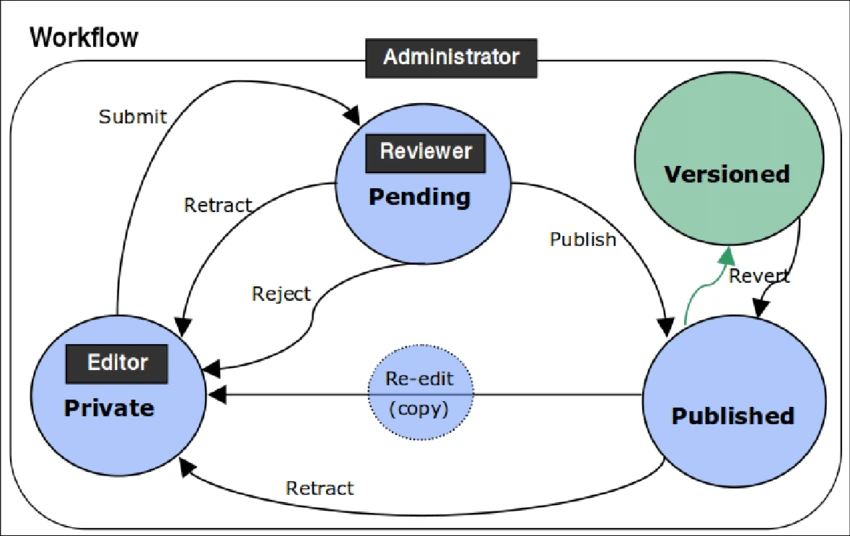Content Management Workflow: How to Optimize Your Team’s Productivity

Content management workflow is critical to any organization’s marketing and content strategy. It involves creating, managing, and publishing content, from ideation to publication. However, managing the workflow effectively can be challenging, especially for larger teams or organizations.
To ensure that your team’s content management workflow is optimized for productivity, you must have a well-defined process and the right tools. In this article, we’ll discuss the key steps you can take to optimize your team’s productivity and streamline your content management workflow. We’ll cover everything from collaborative tools for content creation and editing to how to measure and monitor workflow success.
Effective content management workflow can help improve productivity, streamline processes, and ensure that your team produces high-quality content that resonates with your audience. By following the tips and best practices outlined in this article, you can create a more efficient and effective content management workflow for your team.
In today’s fast-paced digital landscape, content is king, and having a streamlined workflow is critical to staying ahead of the competition. So, let’s dive into the key steps you can take to optimize your team’s productivity and create a more efficient content management workflow.
Understanding the Content Management Workflow
The content management workflow consists of three primary stages: content creation, editing and revising, and approval and publication.

Content creation
The first stage in the workflow is content creation. This is where ideas are generated and the content is written. At this stage, it’s essential to establish clear guidelines and expectations for the type of content your team should produce. A well-defined content strategy and style guide can help ensure your team creates content that aligns with your brand’s voice and tone.
Editing and revising
Once the content is created, it moves into the editing and revising stage. This is where the content is refined, errors are corrected, and the structure is optimized for readability. Collaborative tools like Google Docs or Microsoft Teams can be helpful at this stage to enable team members to work together and make real-time changes.
Approval and publication
After the content has been edited and revised, it moves to the approval and publication stage. This is where the content is reviewed, and any final changes are made before it’s published. At this stage, it’s essential to have a clear process for approving content to avoid delays in publishing.
Identifying Bottlenecks in the Workflow
Bottlenecks are points in the workflow where productivity slows down, causing delays in content creation and publication. Identifying and addressing bottlenecks in the workflow is critical to optimizing productivity.
a. Common bottlenecks in content management workflow
Some common bottlenecks in content management workflow include:
Lack of clear process: If there is no clear process for content creation and management, it can lead to confusion, delays, and mistakes.
Poor communication: Communication breakdowns between team members can cause delays, missed deadlines, and errors in content creation.
Inefficient collaboration: Inefficient collaboration between team members can cause delays and mistakes, leading to lower quality content.
Limited resources: Limited resources, such as time, budget, or personnel, can limit the ability of the team to create and manage content effectively.
Inadequate technology: Using outdated or inadequate technology can slow down the content creation and management process, leading to delays and errors.
Quality control issues: If there is no proper quality control in place, it can lead to errors and inconsistencies in the content, affecting the credibility and effectiveness of the content.
Lack of accountability: Without clear accountability, team members may not feel responsible for their work, leading to delays and lower quality content.
Addressing these common bottlenecks in content management workflow can help ensure that your team is productive, efficient, and producing high-quality content that meets the needs of your audience. By identifying and addressing these bottlenecks, you can streamline your workflow and improve your team’s overall performance.
b. Identifying bottlenecks in your team’s workflow
To identify bottlenecks in your team’s workflow, it’s essential to analyze the content management workflow step by step. Identify areas where delays occur or where team members are overburdened with tasks. Once identified, take steps to eliminate or minimize these bottlenecks.
Streamlining the Workflow for Productivity
Streamlining the workflow can help optimize team productivity by reducing delays and improving efficiency. Here are some tips to help streamline your team’s content management workflow:
a. Collaborative tools for content creation and editing
Collaborative tools like Google Docs, Asana, or Trello can help optimize the content creation and editing process. These tools enable team members to work together in real-time, making it easier to collaborate and share feedback.
Using a shared document or task list also helps. It ensure that team members are working on the most critical tasks and that nothing falls through the cracks. This can be especially helpful for remote teams or teams that work across different time zones.
b. Automating the approval process
Manual approval processes can be time-consuming and can slow down the workflow. Consider automating the approval process to reduce delays and improve efficiency.
One way to do this is by using a content management system that allows for automated workflows. For example, you can set up a workflow where content is automatically sent for review and approval once it’s been edited and revised.
c. Implementing a content calendar
Your team can use a content calendar to stay on track and publish content on time. The calendar must include deadlines for content creation, editing, and publication, as well as details about the type of content being created.
Having a content calendar in place can help minimize bottlenecks and ensure that team members are working on the most critical tasks.
Monitoring and Measuring Workflow Success
Once you’ve streamlined your team’s content management workflow, it’s essential to monitor and measure its success. This can help you identify areas for improvement and make adjustments as needed.
a. Tracking progress with metrics and analytics
Metrics and analytics can help you track your team’s progress and identify areas for improvement. For example, you can track metrics like the time it takes to create and publish content, the number of revisions needed, or the number of articles published per month.
b. Assessing team performance and identifying areas for improvement
Regularly assessing team performance can help you identify areas for improvement and make adjustments to the workflow as needed. Consider setting up regular team meetings to discuss progress, challenges, and opportunities for improvement.
Conclusion
Optimizing your team’s content management workflow is essential to ensuring that you produce high-quality content efficiently. To improve your team’s productivity and ensure timely content publishing, you must understand the workflow, identify bottlenecks, streamline the process, and monitor success.
FAQs
What is a content management workflow? A content management workflow refers to the process of creating, editing, approving, and publishing content.
Why is it important to optimize team productivity?
Optimizing team productivity can help ensure that you produce high-quality content efficiently and that it’s published on time.
What are some common bottlenecks in content management workflow?
Some common bottlenecks in content management workflow include a lack of collaboration between team members, inefficient tools and technology, and poor communication.
How can I streamline my team’s content management workflow?
You can streamline your team’s content management workflow by using collaborative tools, automating the approval process, and implementing a content calendar.
How can I monitor and measure workflow success?
Monitoring and measuring your team’s content management workflow success is crucial to ensuring that your team is meeting its goals and producing high-quality content. Here are some ways you can monitor and measure workflow success:
Tracking progress with metrics and analytics
Metrics and analytics can help you track your team’s progress and identify areas for improvement. You can track metrics like the time it takes to create and publish content, the number of revisions needed, or the number of articles published per month. By tracking these metrics, you can identify bottlenecks and make adjustments to the workflow as needed.
Assessing team performance and identifying areas for improvement
Regularly assessing team performance can help you identify areas for improvement and make adjustments to the workflow as needed. Consider setting up regular team meetings to discuss progress, challenges, and opportunities for improvement. This can help ensure that everyone is on the same page and that the team is working efficiently.
Analyzing customer feedback
Analyzing customer feedback can help you gauge how well your team’s content is resonating with your audience. Consider setting up surveys or feedback forms to gather feedback on your content. This can help you identify areas for improvement and ensure that your team is producing content that meets your audience’s needs.
By monitoring and measuring workflow success, you can identify areas for improvement and adjust your team’s workflow to improve productivity and efficiency.
Read more about content management on our website www.contenterp.com

